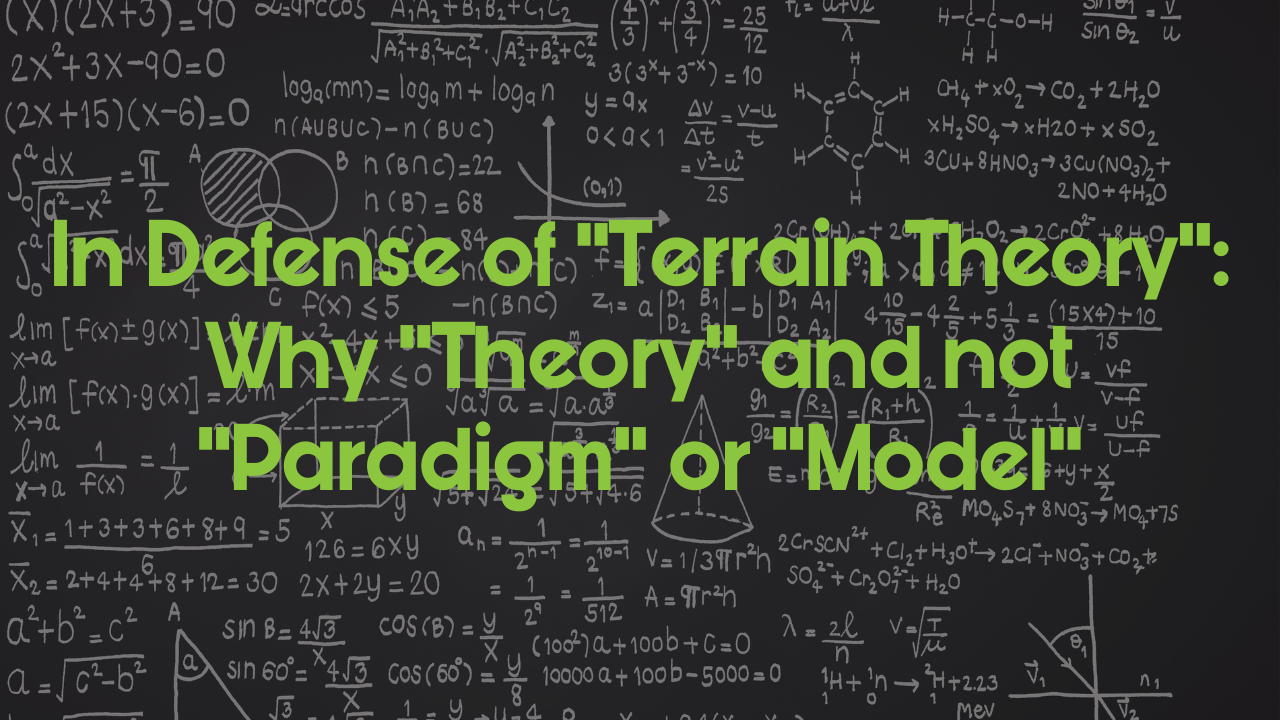In Defense of “Terrain Theory”: Why "Theory" and not "Paradigm" or "Model"

Language matters.
The words we choose shape the way ideas are understood, debated, and carried forward.
Within the natural health and biological reform communities, the phrase terrain theory has become a touchstone. A banner under which those who challenge the mainstream germ-centric view of health can gather
Yet in recent years, some have suggested that the term “terrain paradigm” or “terrain model” might be more accurate or less controversial. They argue that the word “theory” implies something unproven, speculative, or pseudoscientific. Or they proffer that the Terrain approach to health reflects an immutable “natural law”.
But this argument misunderstands what a scientific theory actually is — and, ironically, gives away the ground that terrain thinkers have worked hard to reclaim.
To defend the use of the phrase "terrain theory" is not merely to quibble over semantics; it’s to assert that the terrain-based understanding of biology/health/life deserves to be recognized within the same linguistic framework that science itself uses to describe coherent, evidence-based explanations of nature.
The word “theory” in science is not a guess. It’s not a hunch. It’s not a fringe idea.
Rather, a theory is the highest form of understanding science can offer: a comprehensive explanation of phenomena grounded in observation, evidence, and repeated validation across contexts.
Let’s unpack why, by that definition, terrain theory is precisely the right term…and why alternative phrases like paradigm or model actually weaken the intellectual and scientific standing of the terrain perspective.
What “Theory” Really Means in Science
In common speech, “theory” often means “a guess” – something we’re not yet sure of. People say, “It’s just a theory,” as if theory sits on the bottom rung of certainty.
But in science, it’s the opposite. A scientific theory represents a synthesis of facts, laws, tested hypotheses, and observations that together explain a natural phenomenon. Theories are not fragile; they are robust frameworks that have endured rigorous scrutiny. Theories can evolve, but they rarely collapse without overwhelming evidence.
Consider examples from conventional science:
-
The theory of gravity attempts to explain the attraction between masses.
-
The theory of evolution attempts to explain how species change over time through natural selection.
-
The germ theory of disease attempted to explain how microorganisms can cause illness.
The issue with each of these examples is, of course, that almost everyone within the Terrain space outright refutes at least one of these (germ theory), and many are jumping on the bandwagon to reject the other two.
And in so doing, the very notion of a “theory” is being discarded as well.
Out goes the baby with the bathwater.
The problem is not the notion or scientific definition of a “theory”. The problem is that our best-known examples of “theories” happen to be riddled with holes and issues yet are still held up as irrefutable.
We must not abandon scientific thinking nor the scientific method simply because mainstream science – Big Science, if you will – resists the legitimate challenges against its established theories.
To call something a theory is to recognize its maturity, its explanatory power and internal consistency.
That is precisely what the terrain perspective aspires to and, for many practitioners and researchers, has achieved.
Why “Terrain Theory” Fits That Definition
At its core, terrain theory is not an abstract belief but a coherent framework that integrates physiology, ecology, and energetic principles to explain health and disease. It posits that the state of the internal terrain – the quality of the body’s fluids, tissues, and energetic balance – determines susceptibility to dis-ease or illness, rather than the presence of or exposure to external “germs.”
This idea has empirical support stretching back to the work of Antoine Béchamp, Claude Bernard, Günther Enderlein, and modern-day research into pleomorphism and the biofield.
Terrain theory explains observable phenomena that conventional germ theory failed to account for:
-
Why some individuals exposed to the same alleged pathogen fall ill while others do not (see also Failed Contagion Studies).
-
Why microbial forms can shift and adapt within a single host environment (pleomorphism).
-
Why chronic diseases correlate with internal imbalances rather than persistent external “infections”.
These are not isolated anecdotes. They form a body of evidence pointing toward a more dynamic and ecological understanding of the human body.
Like any strong scientific theory, terrain theory provides explanatory depth: it accounts for the data and also predicts outcomes.
When the terrain is optimized – through nutrition, detoxification, emotional balance, and natural rhythms – health emerges naturally.
When the terrain is toxic, stagnant, or energetically depleted, imbalance and illness arise.
That’s not a loose philosophy or a personal worldview.
It’s an explanatory framework grounded in biological observation.
And by that standard, it meets the very definition of a theory.
“Paradigm” and “Model”: Do They Miss the Mark?
The word paradigm, popularized by Thomas Kuhn in The Structure of Scientific Revolutions, refers to a shared set of assumptions or methods that define how a scientific community operates.
Paradigms are sociological, not scientific, structures.
To call terrain understanding a paradigm is to suggest it’s merely an alternative worldview. A different lens, but not necessarily a scientific explanation. It places terrain thinking on the level of philosophy or perspective, rather than within the domain of biology and natural law.
Similarly, the term model is weaker still. In science, a model is a simplified representation. A conceptual or mathematical simulation used to approximate how a system behaves.
Models are tools within theories. They don’t explain reality on their own; they help test or visualize theoretical relationships.
To call it the “terrain model” would reduce the depth of the framework to a working hypothesis. A rough map, not the territory itself.
Terrain theory, by contrast, aspires to explain the mechanisms of health and disease. It describes how biological systems interact with their environment, how energetic balance shapes cellular behavior, and how microorganisms participate in homeostasis rather than invading it. It’s not just a model or a paradigm shift – it’s a comprehensive biological theory.
Language and Legitimacy
The choice of words affects not just perception but legitimacy.
Critics of terrain theory often weaponize the term “theory” as a pejorative, claiming it lacks evidence or modern validation. Ironically, mainstream science uses “theory” to describe its strongest frameworks.
To retreat into “terrain paradigm” or “terrain model” is to concede the argument before it begins. It implies that terrain-based biology is not yet a mature scientific framework, but rather a fringe perspective or metaphor.
In truth, many of the latest discoveries in microbiology, epigenetics, systems biology, and the human microbiome are converging toward terrain principles – recognizing that the body’s internal environment and its microbial communities are co-regulated systems, not battlefields.
As mainstream science moves closer to ecological and holistic models of biology, the terrain theory stands ready not as an alternative worldview, but as a coherent, predictive theory of life – one that integrates new evidence instead of resisting it.
Reclaiming “Theory” as the Scientific Birthright of the Terrain Perspective
The deeper purpose of using the word theory is to affirm that the terrain perspective is not mystical, speculative, or merely alternative. It’s a natural science rooted in observation, experimentation, and lived reality. Terrain is a “theory” because it explains rather than preaches.
The human organism is not a sterile machine but a living ecosystem. Health is not the absence of microbes and “germs” but the presence of balance.
The body’s terrain – its fluids, its electrical charge, its energetic harmony – is the ground of being from which life and illness both arise. That is the terrain theory in essence: a rigorous, integrative framework that unites the physical, biological, and energetic sciences into a single living picture.
To call it anything less is to underestimate its scope.
A Final Word
Choosing to use the term terrain theory is an act of intellectual precision and philosophical courage. It affirms that those who study and live by terrain principles are not dabbling in speculation but engaging in legitimate scientific inquiry. The word “theory” is not a weakness – it’s a crown earned by explanatory power.
Germ theory once challenged the medical orthodoxy of its time. Yes, it was adopted as – and remains – the leading theory to explain disease and illness, despite its lack of credible scientific evidence.
Terrain theory challenges the mechanistic, material, and reductionist view that dominates modern medicine. The word “theory” keeps it in that arena – the arena of ideas that can be tested, refined, and proven in the real world.
If the goal is to advance understanding, not retreat into linguistic safety, then the choice seems clear. Terrain theory stands not as an opinion or a model, but as a scientific theory worthy of its name.








